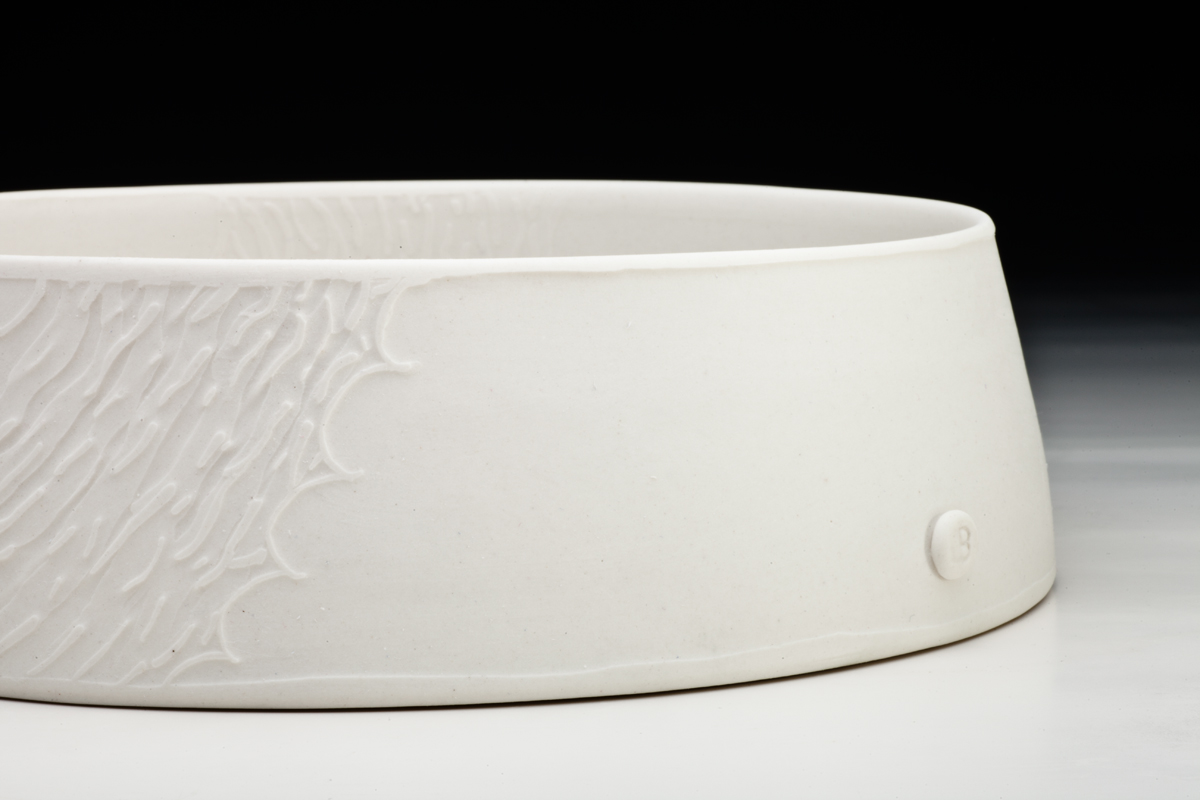A Sea Inside
This body of work was essentially an examination on how climate change has affected our local marine environment.
My fragile weavings of porcelain urchin spines and pierced kelp are my reflection on new pressures on our Tasmanian marine environment. They intertwine two species, the long spined sea urchin (Centrostephanus rodgersii) and Bull Kelp (Durvillaea potatorum). The long spined sea urchin migrated south with the warmer East Australian current’s insurgence into Tasmanian waters. These urchins feed on seaweeds and have formed ‘urchin barrens’ areas devoid of biodiversity on the East Coast. The East Australian Current is also nutrient poor unlike the nutrient rich waters of the Southern Ocean. Many seaweed beds have declined due to ecological change from urchin barrens, temperature and nutrient stresses.
As an installation, crowded together, my dark foreboding urchin bowls create the impression of a barren site, providing strong visual competition to the lighter native urchin.
My Derwent Estuary vessels, each decorated to represent the local seaweeds cast up on my local Kingston beach, provide a small glimpse of the extraordinary diversity of the Tasmanian temperate marine gardens.
This body of work explores fragility, interconnectivity and resilience; a probing of Tasmania’s astonishing temperate marine environment’s ability to survive change.
Derwent Estuary Vessels
Porcelain 235mm x 65mm
My Derwent estuary vessels are each decorated to represent particular seaweeds found cast up on my local Kingston beach. They provide a small glimpse of the extraordinary diversity of the Tasmanian temperate marine gardens.
Palm Weed (Ecklonia radiata)
Bull Kelp (Durvillaea potatorum)
Giant Kelp/String Kelp (Macrocystus pyrifera)
Wakame (Undaria pinnatifida)
Lessonia corrugata
Crayweed (Phyllospora comosa)
Photo credit Uffe Schultze
Urchin Barren Bowls
Stoneware - Matt Black/White Satin 240mm x 67mm/132mm x 58mm
The long spined sea urchin (Centrostephanus rodgersii) migrated south with the warmer East Australian current’s insurgence into Tasmanian waters. These urchins feed on seaweeds, and have formed ‘barrens’ devoid of biodiversity on our east coast. Crowded in together, my dark foreboding urchin bowls create the impression of a barren site, providing strong visual competition to the lighter native urchin.
Photo credit Uffe Schultze
Across Oceans
UK Black & Southern Ice Porcelain Spines and Bull Kelp Weaving 1400mm x 520mm
Incorporating this black clay from the United Kingdom serves as a reminder that the ocean connects us like earths ‘blue heart’. Many similar seaweed species occur in temperate zones around the globe.
Photo credit Uffe Schultze
Ecosystem Tipping
Southern Ice Porcelain Spines and Bull Kelp Weaving 1800mm x 610mm
Degraded/stressed marine ecosystems show small markers before ‘flipping’ or ‘tipping’ into collapse. Scientists are applying a mathematical approach to complex systems and ecosystems dynamics to supply early warning systems.
Photo credit Uffe Schultze
Complex systems
Porcelain and Kelp Weaving 2340mm x 650mm
This weaving was designed so that each spine connected with two of the three kelp stands. Once hung it forms a complex network of intersecting spines and shadows. This work symbolises how ocean climate and the parallel shift in species distribution can have a cascading effect on rocky reef systems.
Photo credit Uffe Schultze













